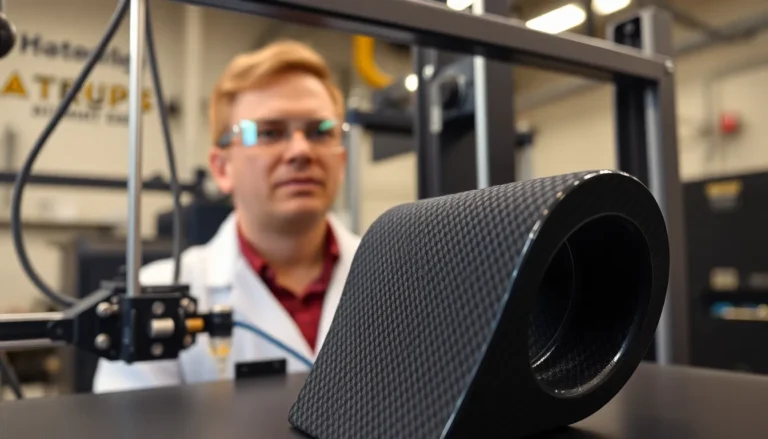Table of Contents
ToggleImagine a world where chemistry doesn’t just wear a lab coat but also a green cape. Welcome to the realm of green chemistry, where scientists are the superheroes battling pollution and waste with eco-friendly solutions. This isn’t just about mixing test tubes; it’s about crafting a sustainable future while keeping Mother Nature smiling.
Overview of Green Chemistry
Green chemistry focuses on designing chemical processes and products that minimize environmental impacts. It prioritizes sustainability by reducing waste and energy consumption during production.
Principles guide green chemistry, including the prevention of waste, the use of safer solvents, and the design of less hazardous substances. For example, substituting toxic chemicals with benign alternatives enhances safety on a commercial scale.
Life cycle analysis plays a significant role in evaluating the environmental impact of chemical processes. This assessment includes extraction, production, use, and disposal phases, ensuring that every step aligns with green chemistry principles.
Collaboration among scientists, industry, and policymakers fosters advancements in this field. Researchers develop innovative technologies that enhance efficiency and reduce ecological footprints. Such advancements offer promising solutions for industries, including pharmaceuticals, materials science, and agriculture.
Green chemistry not only addresses current environmental challenges but also promotes a culture of sustainability. This approach encourages the development of eco-friendly products, leading to a cleaner and healthier planet.
A growing number of educational programs focus on green chemistry principles, preparing the next generation of chemists for sustainable practices. Universities and institutions worldwide integrate this curriculum to ensure future innovation remains environmentally conscious.
By prioritizing green chemistry, the scientific community contributes to a more sustainable future, reflecting a deep commitment to protecting the environment. This commitment strengthens the connection between chemistry and ecological conservation, aiding in the transition toward a greener economy.
Principles of Green Chemistry

Green chemistry encompasses twelve principles aimed at reducing the environmental impact of chemical processes. These principles guide the design and implementation of sustainable practices within the industry.
Prevention of Waste
Preventing waste stands as a fundamental principle of green chemistry. It targets the elimination of unwanted byproducts during chemical processes. Efficient reactions achieve high yields, thus minimizing materials that end up as waste. Utilizing atom economy ensures that more of the starting materials become part of the final product. Technologies promoting this principle help industries save costs while reducing contamination risks.
Design for Energy Efficiency
Energy efficiency plays a critical role in green chemistry. Processes that require less energy contribute significantly to a lower environmental footprint. Effective designs prioritize reactions at ambient temperature and pressure, which decrease energy consumption. Methods that utilize microwave or ultrasound energy demonstrate practical applications of this principle. Maximizing energy efficiency not only lessens resource depletion but also reduces greenhouse gas emissions.
Use of Renewable Feedstocks
The use of renewable feedstocks is a key principle in sustainable chemistry. It promotes sourcing raw materials from renewable resources instead of finite fossil fuels. Biomass, for example, offers a sustainable alternative, providing essential materials without depleting non-renewable reserves. Additionally, utilizing agricultural byproducts encourages a circular economy. This approach enhances resource efficiency while reducing environmental impacts associated with extraction and processing.
Applications of Green Chemistry
Green chemistry finds extensive applications across various industries, promoting sustainability and reducing environmental impacts. Its principles guide innovations that enhance safety and efficiency in processes.
Pharmaceutical Industry
Chemists apply green chemistry principles in the pharmaceutical industry to minimize waste and hazardous materials. Techniques such as solvent-free synthesis and continuous flow processes enhance efficiency while reducing energy consumption. Additionally, the use of biocatalysts replaces traditional harsh chemicals, yielding safer and more sustainable pharmaceutical products. Regulatory agencies increasingly favor these environmentally friendly methods, encouraging pharmaceutical companies to adopt greener practices.
Agriculture and Food Production
In agriculture and food production, green chemistry facilitates the development of sustainable pesticides and fertilizers. Chemical processes focus on reducing toxicity and enhancing biodegradability in agricultural inputs. Moreover, the utilization of natural substances derived from renewable resources supports eco-friendly farming practices. As a result, agricultural yield increases while minimizing harmful environmental effects. Collaborative research between scientists and farmers further promotes the implementation of green chemistry techniques in modern agriculture.
Material Science
Material science benefits significantly from green chemistry through the creation of biodegradable and recyclable materials. Innovations include bio-based polymers and composites that reduce dependency on fossil fuels. Engineers design materials with improved life cycles, ensuring their environmental footprint is minimal. Companies increasingly prioritize the development of sustainable products that meet consumer demand for eco-friendly solutions. Enhanced material performance not only satisfies regulatory concerns but also aligns with global sustainability goals.
Challenges in Implementing Green Chemistry
Implementing green chemistry faces several challenges that hinder its widespread adoption across industries.
Economic Considerations
Costs associated with green chemistry can be significant. Transitioning from traditional methods to sustainable practices often involves initial investments in new technologies or materials. Industries might resist adopting these processes if perceived costs outweigh long-term benefits. Moreover, smaller companies may struggle with limited resources, making it difficult to implement eco-friendly solutions without financial support. Funders and stakeholders must understand the value of investing in sustainable practices for economic growth and environmental preservation.
Regulatory Frameworks
Regulatory frameworks frequently lag behind advancements in green chemistry. Many regulations were established decades ago and do not reflect modern sustainable practices or technologies. Updating these frameworks poses challenges for regulators, scientists, and companies. Complexities can arise when integrating new standards into existing processes. Collaborative efforts among governments, organizations, and research institutions are essential to ensure regulations promote rather than hinder innovation.
Public Awareness
Public awareness often impacts the adoption of green chemistry. Many consumers remain unaware of environmental issues related to traditional chemical processes. Increasing recognition of green chemistry’s benefits is essential for fostering consumer demand for sustainable products. Education campaigns can illuminate the advantages of eco-friendly alternatives, encouraging individuals to make informed choices. Engagement with communities via workshops and online resources enhances public understanding and supports the shift toward sustainable practices.
Future Trends in Green Chemistry
Emerging trends in green chemistry focus on enhancing sustainability across various sectors. Innovative approaches involve integrating renewable materials, shifting the supply chain towards biomass, and promoting energy-efficient processes. Researchers develop new methodologies that harness waste materials, bringing about a circular economy and reducing resource depletion.
Advancements in synthetic biology are gaining momentum. Scientists utilize engineered microorganisms for producing chemicals, reducing the reliance on fossil fuels and conventional chemical processes. Such biotechnological innovations showcase significant potential for sustainable production methods.
Collaboration with industry stakeholders plays a crucial role in driving green chemistry initiatives. Companies increasingly adopt eco-friendly practices as consumer demand for sustainable products rises. Partnerships between academia and industry enable the exchange of knowledge, paving the way for groundbreaking discoveries in cleaner technologies.
Regulatory frameworks are evolving to support green chemistry advancements. Governments recognize the need for more robust policies that promote environmentally friendly chemical practices. These regulatory changes encourage innovation while ensuring public safety and environmental protection.
Education and outreach programs are essential for instilling green chemistry principles in the next generation. Universities expand curricula to emphasize sustainability and environmental responsibility in chemical education. Engaging students fosters a culture of innovation, encouraging young chemists to develop sustainable solutions for future challenges.
Finally, increased investment in green chemistry research accelerates the transition towards sustainable practices. Funding opportunities arise from both public and private sectors focusing on environmentally friendly technologies. Such investments contribute to a sustainable economy, aligning short-term goals with long-term environmental benefits.
Embracing green chemistry represents a pivotal step toward a sustainable future. By prioritizing eco-friendly practices and innovative solutions, it addresses pressing environmental challenges while fostering a culture of sustainability. The collaboration among scientists, industries, and policymakers plays a crucial role in advancing these principles, driving the development of safer and more efficient chemical processes.
As awareness grows and educational initiatives expand, the next generation of chemists will be better equipped to implement sustainable practices. The ongoing investment in research and the evolution of regulatory frameworks will further support this transition, aligning economic growth with environmental stewardship. A commitment to green chemistry not only protects the planet but also paves the way for a healthier and more sustainable world for future generations.




